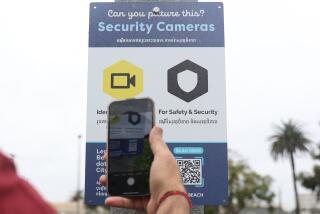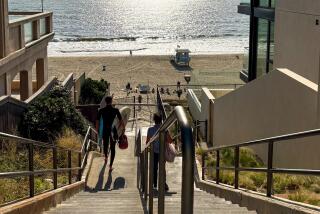Novel Crosswalk Signals Drivers to Pay Attention
Just a few weeks ago, crossing Riverside Drive to catch a bus or go to the Sherman Oaks Fashion Square entailed a mad dash between the cars and a prayer not to be the next one hit as cars and trucks zoomed through the intersection.
Now, thanks to what transportation planners call a “smart crosswalk,” a pedestrian at the Ranchito Avenue intersection where the mall and bus stop are located might feel more like Moses parting the Red Sea. As soon as someone steps up to the curb, bright lines of yellow lights, planted in the asphalt along the boundaries of the crosswalk, flash up from the street, while more lights flash from the sidewalk.
Miraculously, it seems, the waves of autos stop, lining up as if they have hit an invisible wall.
“That was really good!” exclaimed Nick Ziegler, 40, who crossed the street with his mother, Mary, on a recent morning. “They stopped!”
Neighbors and city officials say that until the crosswalk was installed last month, regard for pedestrians in the crosswalk was so low that drivers wouldn’t even stop during obvious police sting operations, when officers dressed as Santa Claus and the Easter Bunny tried to cross the street, and motorcycle cops lined the sidewalks.
Last year, a couple was killed there while crossing the street to catch the bus.
The Sherman Oaks crosswalk, which is the first of its kind in Los Angeles and cost $40,000 to install, is one of several such dramatic crossing signals built throughout the region over the last few years. It was unveiled last month as part of an evolving effort by transportation planners to find better ways to protect pedestrians as city streets grow ever wider and busier.
“We’re going to try to install as many of these devices as we can -- particularly near schools,” said John Fisher, assistant director of the Los Angeles Department of Transportation.
The city already has a number of crosswalks that use flashing overhead lights, Fisher said, but none like this, in which the lights are embedded in the street and set to flash when a hidden camera detects a pedestrian.
It is too soon to tell how well the new crosswalk works, but Fisher said it is expected to significantly increase compliance with state law requiring motorists to yield to pedestrians in crosswalks. At a typical crosswalk, he said, only 40% of motorists stop for people on foot. At those intersections where the city has added overhead flashing lights, as many as 75% of drivers stop.
The smart crosswalk could have even greater compliance, said City Councilwoman Wendy Greuel, who championed the Sherman Oaks project, because the lights are very dramatic and because they flash only when a pedestrian is really present.
“People have ignored [other lighted crosswalks] for years, because they are just the same old flashing lights,” Greuel said.
Not so the new setup, said Ken Gerston, who lives just down the block from the crosswalk and is chairman of the Sherman Oaks Neighborhood Council.
“It’s kind of intimidating,” Gerston said. “When the lights are on, it looks like there’s a traffic collision in front of you. Instinctively you want to slow down and look.”
The city of Glendale has installed 32 of the crosswalks since 2000, said Jano Baghdanian, the city’s traffic and transportation administrator. They differ slightly from the Sherman Oaks setup, Baghdanian said, because they don’t come on automatically when a pedestrian steps up to the curb. Instead, people wanting to cross the street must push a button to start the lights flashing.
“They truly make people slow down and look for pedestrians,” said Baghdanian, who estimates that the lighted crosswalks in his city cause about 90% of drivers to stop for pedestrians.
Santa Monica also has several smart crosswalks. Like those in Glendale, they require pedestrians to push a button to signal their presence, and then allow people about 20 seconds to cross the street.
“We deliberately chose not to have the camera version of it,” said Ellen Gelbard, assistant director of planning and community development for Santa Monica. She said city planners were concerned that a camera or motion detector might malfunction or fall prey to vandals.
The push-button version is between $10,000 and $15,000 less expensive too, because it uses a solar panel and does not require running electric wires for the camera or the lights.
Greuel and others in Los Angeles, however, say the automatic system may be the safest because it is set to start whether or not the pedestrian remembers to push the button.
Working in the background, she said, the system may not be so obvious to pedestrians, and also might alleviate concerns that people on foot could get a false sense of security from the crosswalk. To further address those concerns, the crosswalk lights are installed in such a way that they point out, toward the cars, an area not visible to the pedestrian.
Nick and Mary Ziegler said that, far from a false sense of confidence, they’re still pretty nervous about crossing Riverside Drive to get to the mall and back.
On most occasions, they said, they walk another quarter-mile to Hazeltine Avenue, crossing there because there is a regular traffic signal.
“It’s a hundred times better than it was,” Nick Ziegler said. “But we still cross at the light.”
*
If you have a question, gripe or story idea about driving in Southern California, write to Behind the Wheel, c/o Los Angeles Times, 202 W. 1st St., Los Angeles, CA 90012; or send an e-mail to behindthewheel@latimes.com.
More to Read
Sign up for Essential California
The most important California stories and recommendations in your inbox every morning.
You may occasionally receive promotional content from the Los Angeles Times.









